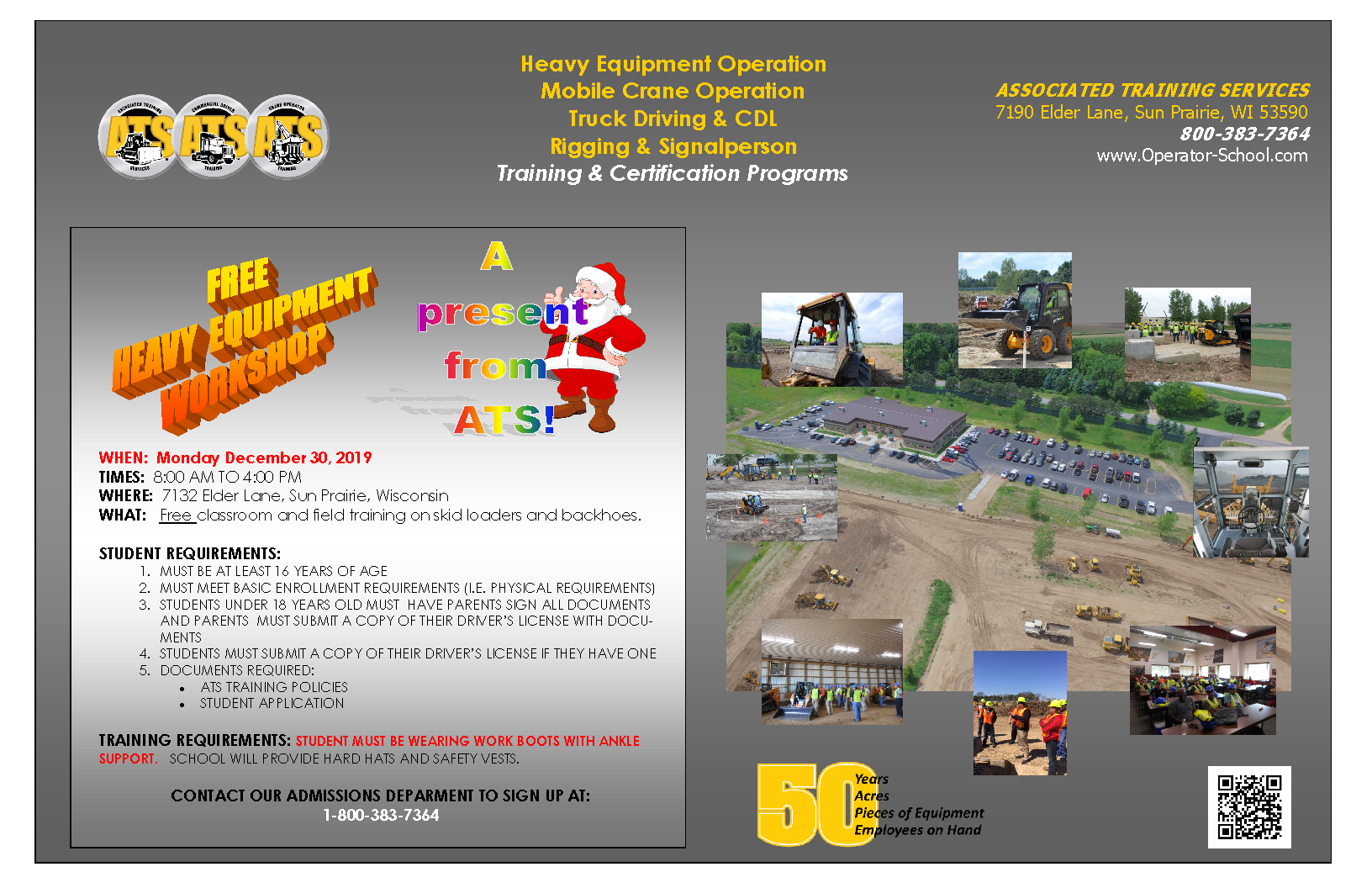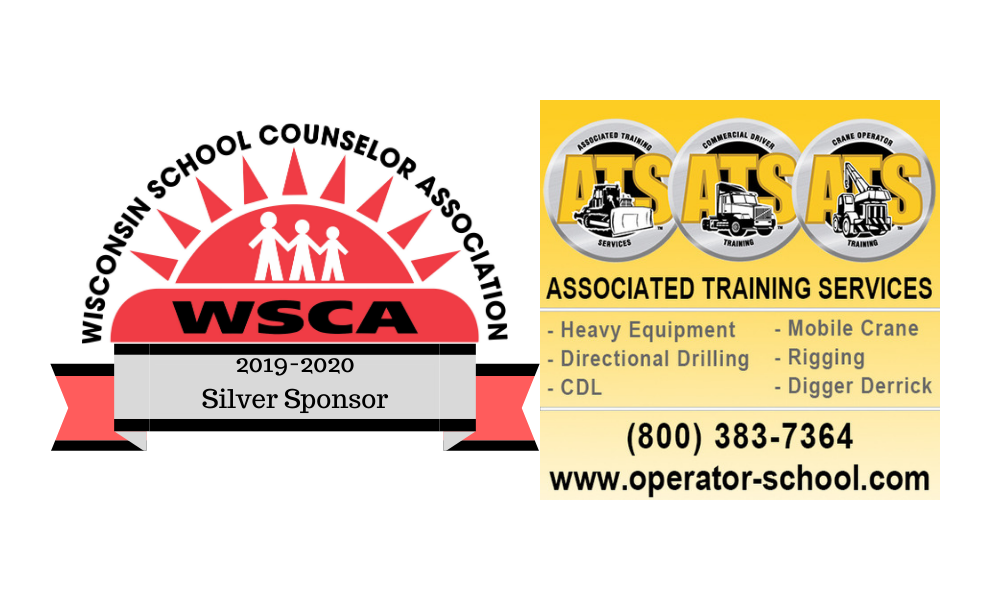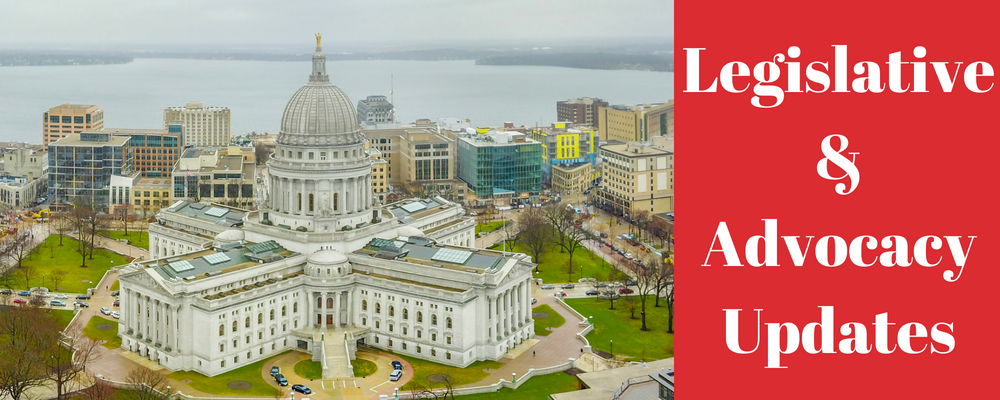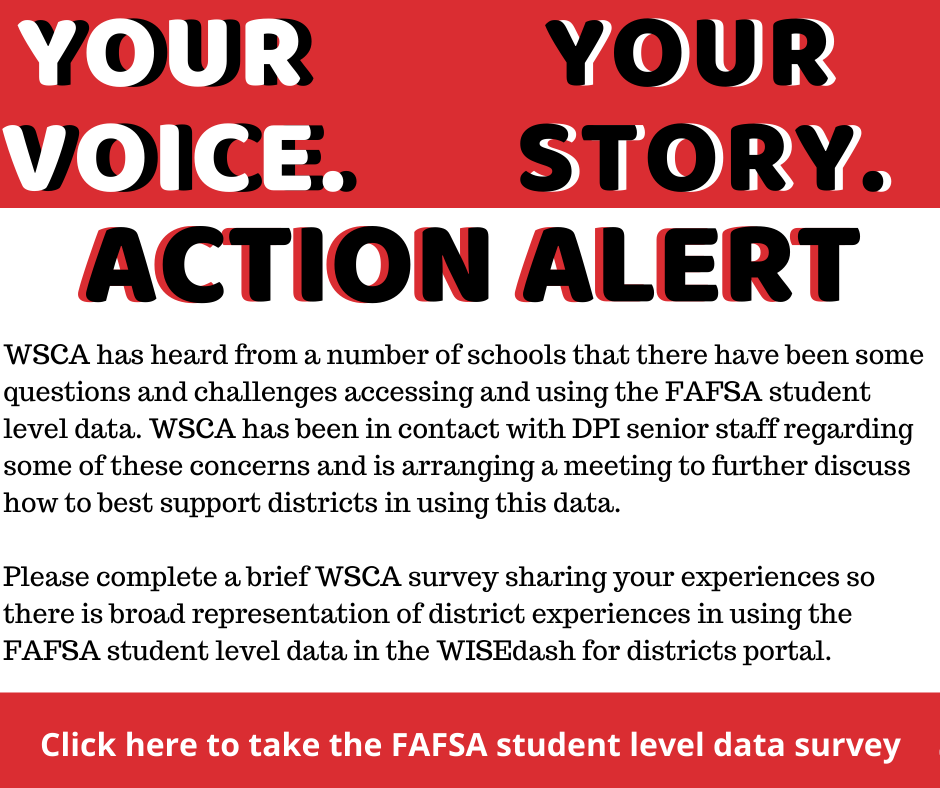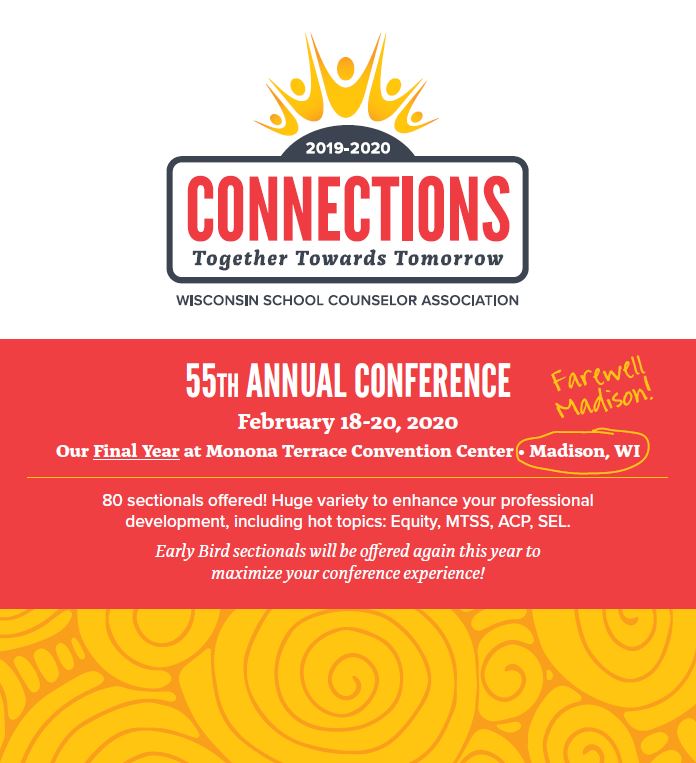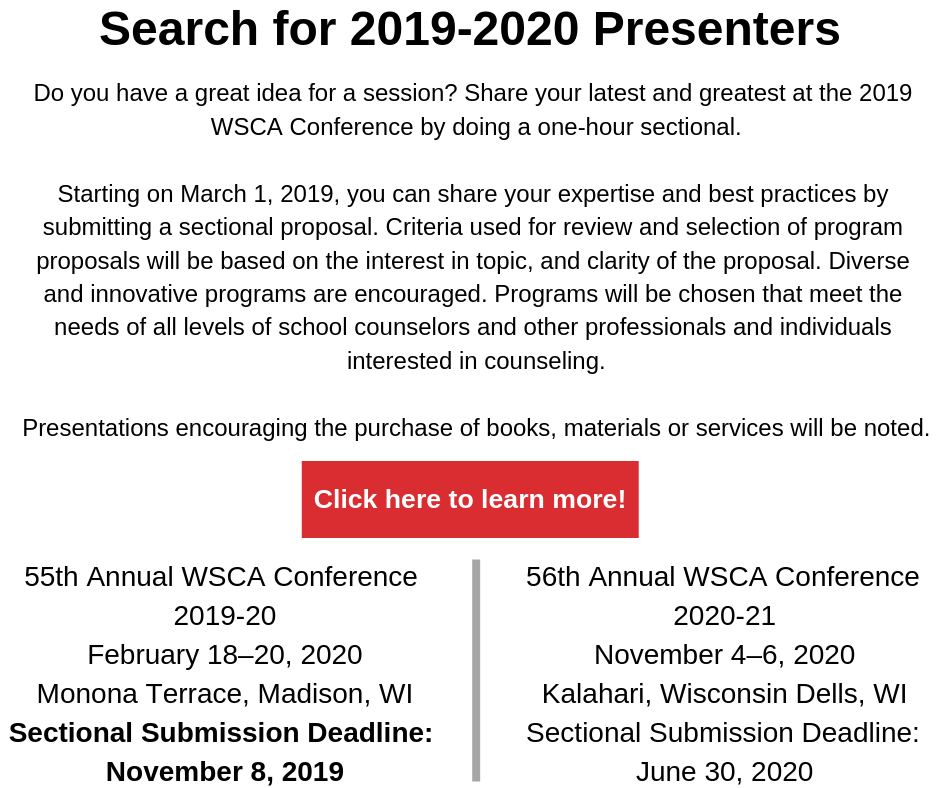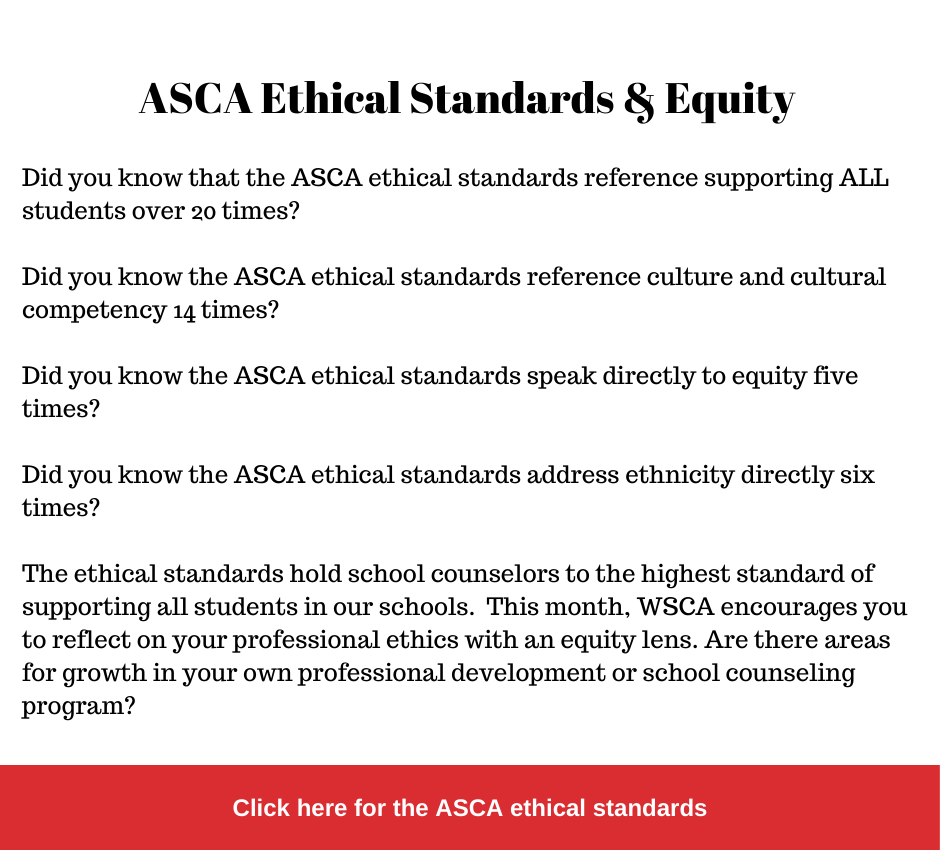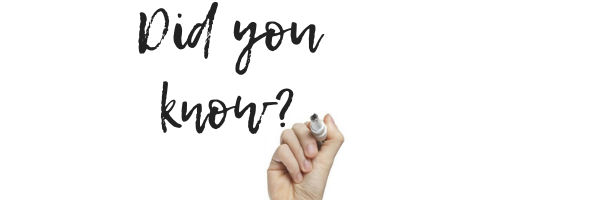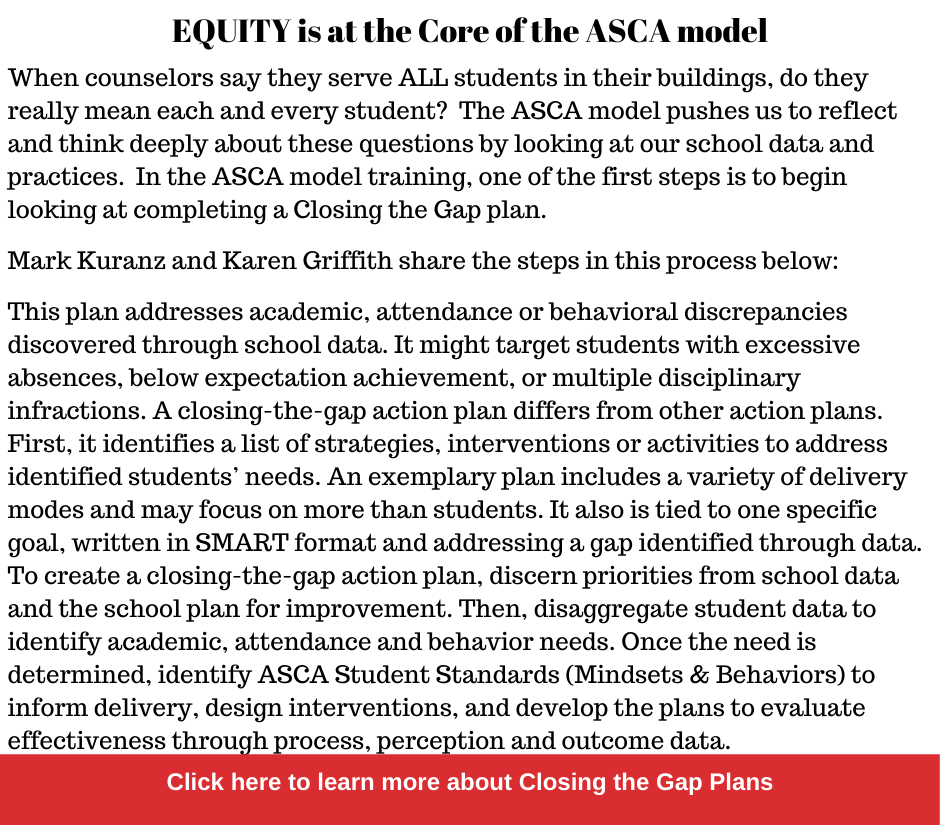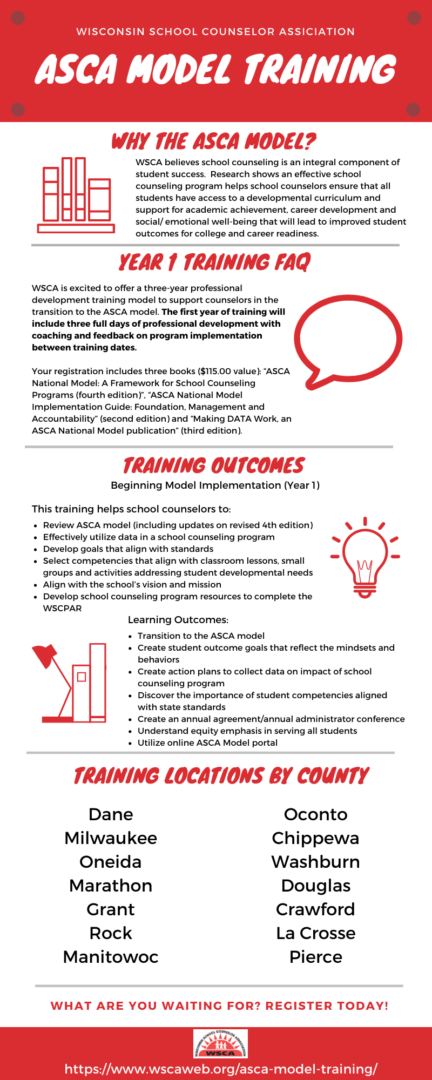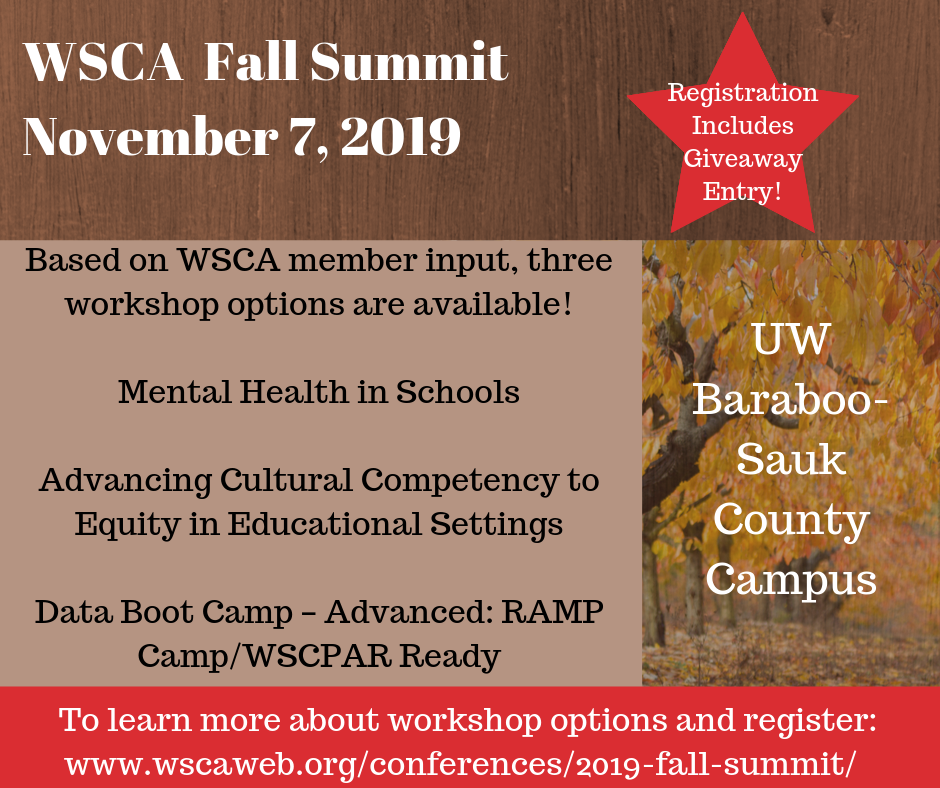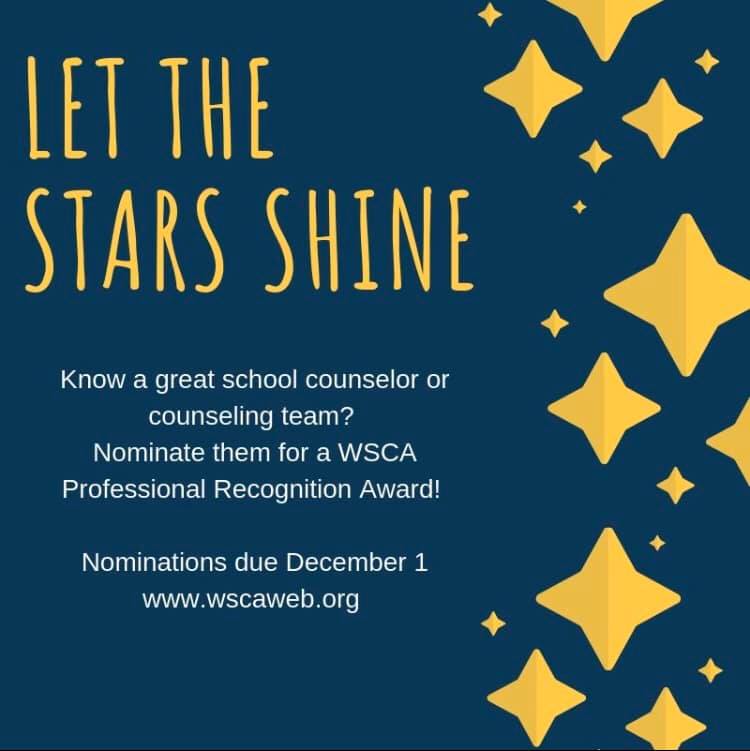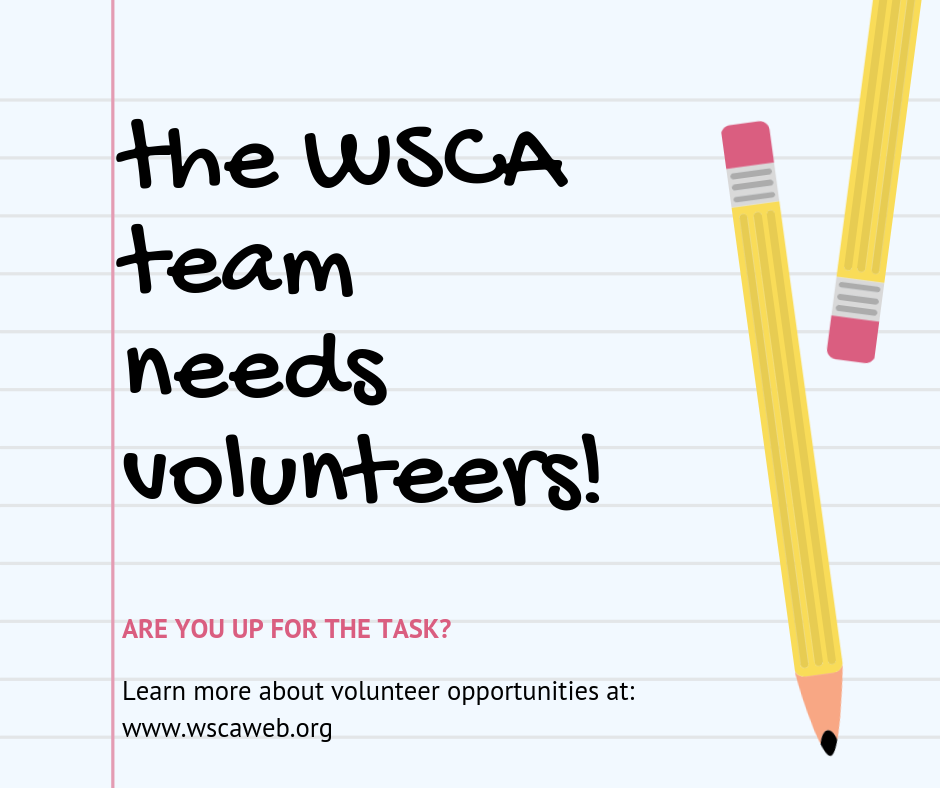November 2019

In This Issue:
A Message from the Executive Director – Courageous Equity Conversations
A Message from the WSCA Board – Ready to Practice Your Leadership Skills on the WSCA Board?
Feature Article – Equity- Prioritizing Personhood
FREE Heavy Machine Workshop for High School Students!
Legislative Update – FAFSA Student Level Data Survey Request
2019-2020 Conference
WSCA Conference Scholarship – Ascendium Fellowship
Dr. Raj (Dr. Niraj Nijhawan) – Conference Closing Keynote Presenter Video
Confernece Sectional Proposals – Deadline Friday November 8th!
Ethics – What does ASCA Ethics Say About Equity Focus
Equitible Career Development Starts in Elementary School
ASCA Model – EQUITY is the core of the ASCA model
ASCA Model Training
Still time to Register – Fall Summit November 7th!
Graduate Student Mike Troy Scholarship
WSCA Professional Recognition Awards
WSCA Volunteers NeededA Message from the WSCA Executive Director
Courageous Equity Conversations
Stacy Eslick, WSCA Executive Director
Wisconsin is in the news again for having the worst black-white student academic disparities in the United States according to the National Assessment of Education Progress — known as the Nation’s Report Card. This combined with the annual reports of the school to prison pipeline, racial segregation, pay gaps, unemployment and incarceration rates often ranks Wisconsin one of the worst for African American families. As an association, we can no longer fall back on the common belief that this is just an urban issue in Milwaukee, Madison, Green Bay, etc. As educators we have a moral, ethical and professional responsibility to help our students live in a global society that supports the best for all children. In small towns across Wisconsin there are stories and examples of students engaging in emotionally harmful acts to populations that are different than the white majority. Districts that have predominantly been small, rural, with primarily white students are seeing an increasing number of diverse families moving into their communities and grappling with how to integrate different life experiences. What we know is that there are usually more similarities than differences, families want what is best for their children.
As I travel across the state and country, I am still amazed and appalled at the conversations other white people will try to engage me in based on the color of my skin and the assumption that I hold the same negative beliefs they do about African Americans, Latinos, and immigrants. Why do they assume that I would agree with their statements? How many white people are willing to stand up to others making these statements and say that you disagree? Silence can imply agreement so I challenge all my white counselor colleagues to engage in these difficult conversations in our communities, we have to start taking a stand against long held institutionalized systemic racism in order to make small changes. Small change will then turn into larger change. Wisconsin is a wonderful state, with great people, how can we make it that way for ALL of our residents? This is not just a problem for Milwaukee and Madison to solve, we as a state can and must do better. Please join WSCA leaders in our ongoing conversations around equity, particularly racial equity, there is a lot of work to do.
A Message from the WSCA Board of Directors
Ready to Practice Your Leadership Skills on the WSCA Board?
Every professional association needs a Board of Directors that provides leadership and vision to ensure that the organization stays relevant for its members. WSCA has a long history of being a great School Counselor Association, benefiting from a tradition of great leadership.
Each year WSCA invites individuals to apply to be a Board Director. If you are looking for a professional leadership opportunity that will expand your understanding of the impact of the school counseling profession, then we encourage you to submit an application this year.
You will experience professional growth in the following areas as a result of being on the WSCA Board of Directors:
- Greater understanding and appreciation of the impact the school counseling profession has in Wisconsin’s educational system
- Expanded vision of the national educational initiatives that are including or asking to include school counselors in addressing PK-12 needs.
- Opportunity to learn and practice leadership skills
- Increase the depth of passion you have for your own practice as a result of seeing and hearing inspiring stories of school counselors in Wisconsin doing spectacular things!
Additional information on the application process, including the criteria for consideration and application can be found at /about-wsca/wsca-leadership-team/wsca-elections-2020-21/.
If you have questions, or want to talk further with a WSCA Board Director about the responsibilities of the position, please contact any of the following Board Directors who are members of the Nominations and Elections Committee:
- Laura Multer (Committee Chair) board+laura@wscaweb.org
- Miriam Brown board+miriam@wscaweb.org
- Steve Schneider board+steve@wscaweb.org
- Donna Okray board+donna@wscaweb.org
Equity – Prioritizing Personhood
By: Shawn Harris M.S. & Carri Hale M.S.
Shawn and Carri are school counselors at Verona Area High School and have presented at the WSCA conference multiple times on the critical importance of equity.
Intro: To help every student feel accepted and find their potential, school counselors must be change agents actively engaged in disrupting institutionalized racism. School counselors by profession adhere to the themes of Collaboration, Leadership, Social Justice and Systemic Change (ASCA, 2019). We challenge you to become grounded in the work for social justice, to be an antiracist, and to get on your journey as a HUMAN, so that in your position of power you can lead toward change.
Wisconsin school counselors: please know that social justice work applies to you even if you don’t think your school is “diverse”. It is imperative that all of our students understand the fundamental principles of respecting others and holding judgment upon that which you don’t know. Students need to understand the hate behind the noose and swastika: the ignorance behind Black face and appropriating dances from other cultures. As leaders in our buildings it is our due diligence to ensure that our students emerge as true world citizens.
Social Justice: the belief that society should not discriminate against any group or individual and a call to action to disrupt entities that do. As school counselors, we have a responsibility to help students identify social injustice and equip them with the tools to resolve injustices in their lives. Racism, sexism, and poverty directly impact our students’ trajectories. These injustices must be interrupted if students are to live in a just society. “This is their world and they need to be aware that they have choices to make and actions to take that will help shape what their world will be like in the future. School counselors have an important role to play in helping students understand the need for respect of self and others, for embracing meaningful relationships that promote individual and social growth, and work to change where that is not occurring” (Squier, 2019).
Because of the versatility of our school counselor role and skill set, we have a unique opportunity to lobby for equity on a number of fronts including schools, communities and in legislation. We can provide space for student activism and voice as advisors for affinity groups, work as brokers for partnerships with community resources and change agents in political arenas.
A preliminary step in fulfilling that role is doing the work within ourselves to interrogate our own traditions and beliefs, with the goal of redirecting those values towards the progress of all students while interrupting discriminatory practices.
Trauma: Students carry scars from trauma and we see it in the staggering statistics that disproportionately impact marginalized communities. Doing things the way we have always done them has stifled student success rates and undermined the credibility of schools as safe and supportive environments for students and their families. An emphasis on equity is the best vehicle for disrupting status quo teaching/learning practices that are not inclusive of the skills and experiences of all students.
Financial cost is not an adequate excuse to not build equity in our schools. Equity is an investment we cannot afford to lose out on. It is an investment in personhood (doing the work) and a commitment to celebrating the personhood of others.
Advocacy: As leaders it is our job to take on inequalities as social justice advocates in our schools. To this end, we have to do the work within ourselves. As school counselors, we must understand our biases so we can disrupt systemic programming and choose to respond in a different way. This means learning to pause and reflect, to ensure that our actions bring the balance of power to underserved students, and that what we do does not cause unintentional harm. It is imperative that we work with our administration teams and school districts to advocate for systemic change that truly disrupts predictable outcomes. For every student to succeed, they must have a sense of belonging and acceptance within our entire community.
How to take action: Are you aware of the following terms? Institutionalized/Structural Racism, White fragility, Historical Trauma, Implicit Bias, Microaggressions and Allyship. If not, do your research: There are many ways to learn and grow. Understand your school and community history. Take a look at how the evolution of your community aligns with institutional racism. Think about what it means to be an ally. Take a look at your school data and question, question, question. Who is failing? Who is suspended? Who is sent for office referrals? Why? It doesn’t matter where you are on the journey of understanding, what matters is that you are on the journey. Do your own work. Do a book study. Join a conversation about race. Speak up. Our students need us to be savvy and persistent warriors. Our white students need us to show the way; our students of color and non majority students need us to constantly work to disrupt the system.
Resources
American School Counselor Association (2019). The ASCA national model: A framework for school counseling programs (4th ed.). Alexandria, VA: Author.
Squier, K.L. (2016). A construct based approach to implementing comprehensive school counseling programs. http://excellenceinschoolcounseling.com/wp-content/uploads/2016/03/2.1.4.4-Social-Justice-5-1-16.pdf
Equitible Career Development Starts in Elementary School
Career development often falls off the list of counselor classroom instruction with the move towards increased emphasis on SEL, trauma informed schools, emotional regulation, etc. Research shows that career development is critical in K-8 as children start identifying interests, potential career paths and mindsets about their futures. Looking at the data in STEM fields shows how significant this impacts females and minority youth. This is interesting to reflect on and identify if there are areas of your counseling program that can be modified to support ALL of our students’ continued and ongoing interest in subjects and career paths that will provide them fulfulling careers as well as family sustaining incomes. Many thanks to the iD Tech team for compiling the following STEM education stats.
STEM Education Stats
Here is a quick look at a few of the more popular STEM stats, with details below.
1. STEM jobs are projected to grow 13%.
Between 2017 and 2027, the number of STEM jobs will grow 13 percent, compared to 9 percent for non-STEM jobs—with positions in computing, engineering, and advanced manufacturing leading the way. (Via Education Commission of the States)Overall, since 1990, employment in STEM occupations has grown 79%—increasing from 9.7 million to 17.3 million. (Via Pew Research Center)
2. The average median hourly wage for STEM jobs is $38.85.
Compared to the median earning for all other types of jobs in the US – $19.30 – STEM-related jobs pay exceptionally well. (Via Change the Equation)3. Out of 100 STEM occupations, 93% of them had wages above the national average.
The national average for STEM job annual salaries is $87,570, where the national average for non-STEM occupations sits at roughly half—$45,700. (Via the Bureau of Labor Statistics)So, there IS Increasing demand for STEM jobs…
4. The US placed 38th of 71 countries in math, and 24th in science.
This is according to the Programme for International Student Assessment (PISA)—which is regarded as one of the biggest cross-national tests of its kind. (Via the Pew Research Center; Pew also just published these 7 facts about the STEM workforce on 1/9/18)5. Of 35 members of the Organization for Economic Cooperation and Development, the US ranks 30th in math and 19th in science.
(Via the Pew Research Center)6. Only 36% of all high school grads are ready to take a college-level science course.
(Via the National Math & Science Initiative)7. US universities are expected to produce only 29% of the required number of grads.
That is, to fill the 1.4 million computer specialist job openings. (Projected by the US Department of Labor)But it seems the education system isn’t producing candidates…
8. 74% of middle school girls express an interest in engineering, science, and math…
But only 0.3% choose computer science as a major when they get to college. (Via girlswhocode.org)9. Women make up only 18% of computer science undergrads.
Even though women earn 57% of all bachelor’s degrees, only 18% of undergrad computer science degrees go to females (According to the National Center for Education Statistics)10. Girls’ interest in STEM peaks in middle school, but drops off in high school.
A Microsoft survey conducted in Europe found that girls gain interest in STEM at age 11, but then lose that interest at age 15 (Via Microsoft). The combination of social factors and lack of access can be understood as culprits.Thus, women are vastly underrepresented in STEM…
11. “African-American and Latino workers also now represent 29 percent of the general workforce population (up from about 24 percent in 2001)…
But just 16 percent of the advanced manufacturing workforce, 15 percent of the computing workforce and 12 percent of the engineering workforce.” (US News, 2015)12. Minority women participation in STEM at the collegiate level:
Engineering, 3.1%; Physical Sciences, 6.5%, Mathematics; 5.4%, Computer Science; 4.8%. (Via the National Girls Collaborative Project)And, many minorities are also underrepresented, with a number of reports and quotes on the percentages of minorities in STEM.
Check out the following FREE resources to get you started on your elementary and middle school career development units to promote equity in careers for all of your students!
Girls Who Code: https://girlswhocode.com/about-us/
Women in Technology – Counselors for Computing: https://www.ncwit.org/ncwit-counselors-computing-c4c-materials
Palo Alto Cyber A.C.E.S. – Activities in Cybersecurity Education for Students: https://start.paloaltonetworks.com/cyberaces
Association for Career and Technical Education: https://www.acteonline.org/professional-development/high-quality-cte-tools/career-development/#tab-id-2



